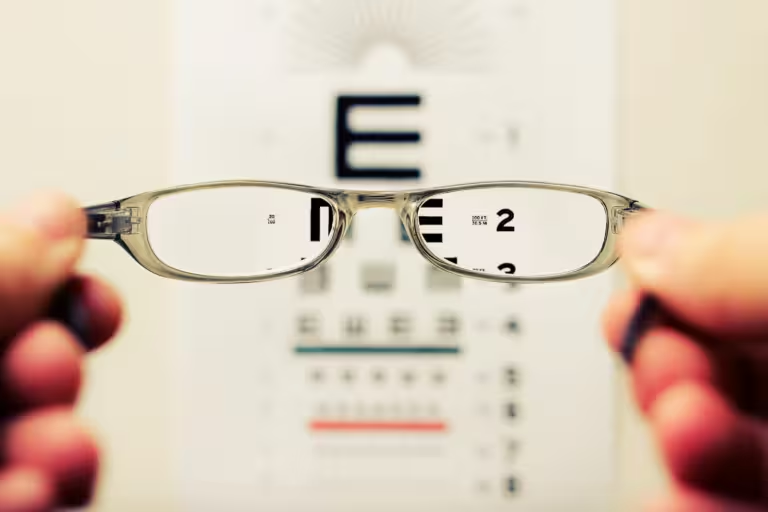What Is 20/40 Vision? Visural Acuity Explained Simply
Roughly 60% of adults in the U.S. wear prescription lenses. That’s over 166 million people. Of those people, few could tell you precisely what their prescription means. 20/40, near-sighted, with a slight astigmatism. It’s all hard to remember, so we’re writing this article. It will outline what it means when you hear “20/40 vision” and how to keep your eye health at its best. Let’s dive in.
Understanding Visual Acuity
Visual acuity is the sharpness of vision, measured by the ability to discern letters or numbers at a given distance according to a fixed standard. Put more simply, how well can you see? It has to do with factors like lens integrity, muscle tone within the pupils, lens shape, etc. All you need to know is that your eyes need to work right to focus clearly.
The standard way to measure visual acuity is using the eye chart you see at most doctor’s offices. You stand 20 feet away and read a series of letters that get progressively smaller. You’ll be given a score with two numbers based on how far down the chart you can read. The first is 20, and the second is usually something else. If the second number is 20, you have perfect vision. But what do these numbers mean?
What does 20/40 vision mean?
20/40 vision means that when standing 20 feet away from something, you can see it as clearly as a person with perfect vision (20/20) would see it from 40 feet away. It’s a way of objectively comparing your vision against someone with no vision issues. Anything worse than 20/200 is considered legally blind.
Having 20/40 vision makes it likely that you’ll need some corrective lenses. Either that or you’ll need to be significantly closer to objects to see them clearly, which may be impractical when driving.
Life with 20/40 vision
1. Reading: Depending on whether or not you’re near or far-sighted, reading may be difficult with 20/40 vision, especially the small print. Reading without proper lighting may also be challenging.
2. Driving: In many states, 20/40 vision is the minimum requirement for an unrestricted driver’s license. However, without corrective measures, be extra careful when driving at night.
3. Work and Hobbies: Occupations and hobbies that require near, far, or consistent switching back and forth between the two may be more challenging without glasses or lenses.
Corrective Options:
Glasses: This is the easiest and most straightforward way to fix the issue. Your eye doctor will give you lenses that help you see more clearly.
Contacts: Same concept but not glasses.
Lasik: A minimally invasive surgery in which the surgeon re-shapes the eye’s cornea. Hence, it refracts light to the back of the eye more effectively.
Vision Exercise: Depending on the mechanism, visual exercises can restore strength and function in the muscles of the eyes and pupils. Concussions can often affect these pathways, and vision therapy is a common way to address these issues when looking for a more permanent solution.
V. Health Considerations and 20/40 Vision
20/40 vision is relatively easy, but you should consider the following factors when contemplating eye health. Depending on the source, it may be a more serious issue and require different treatment than just glasses.
1. Refractive Errors: Myopia (nearsightedness), hyperopia (farsightedness), and astigmatism. Regular eye exams can detect these issues early on.
2. Age-Related Changes: Conditions like presbyopia (age-related difficulty in seeing close objects) or cataracts can affect visual acuity.
3. Eye Diseases: Diseases such as glaucoma or macular degeneration can also impair vision and require timely medical intervention.
4: Functional Causes: Brain injuries often create visual disturbances that can be addressed with appropriate rehabilitative exercise.
5. Diabetes: Unmanaged diabetes can damage small nerves in the eyes, leading to vision changes. If you know you’re dealing with diabetes and your eyesight continues to get worse, contact your doctor and get your blood sugar and A1C tested ASAP.
Steps to Maintain and Improve Eye Health
1. Regular Eye Exams: Be sure to schedule a regular eye exam and make sure your prescriptions are up to date.
2. Eye-Friendly Foods: Foods rich in omega-3 fats, lutein, and vitamins C and E can support eye health. Leafy green vegetables, fatty fish, and citrus fruits are the best for general eye health.
3. Protection: Wear sunglasses that block UV rays to protect your eyes from sun damage. Also, consider protective eyewear for sports or activities that pose a risk to your eyes.
4. Limit Screen Time: Extended screen time can strain your eyes. Follow the 20-20-20 rule: every 20 minutes, look at something 20 feet away for at least 20 seconds.
5. Stay Hydrated: Proper hydration is essential for overall eye health, reducing dryness and irritation.
Conclusion
20/40 vision is another way of saying what you see at 20 feet away; someone with perfect vision could see at 40 feet. It’s quantifying how far your eyesight is from the norm. Anything over 20/200 is considered legally blind. Many causes for deficits in eyesight vary from genetics to concussion. Thankfully, correcting eyesight has become easier and more accessible, with things like LASIK and rehabilitative exercises becoming more common.
If you have questions about eyesight after a concussion, click here to schedule a complimentary consultation with one of our doctors. We’ve treated hundreds of complex neurologic cases and can help piece together the missing pieces in your recovery.
*Note: The information provided in this article is for educational purposes only and does not constitute a doctor-patient relationship. Patients should consult their medical provider or primary care physician before trying any remedies or therapies at home.

